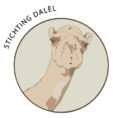
Camel versus Dromedary
Zoology has different names for both:
- Camelus dromedarius = the camel with 1 hump
- Camelus bactrianus = the camel with 2 humps
This makes it clear that the dromedary is simply a camel. We don’t call the 2-humped one “Bactrian” either, do we?
In other words, both species are called camel.
In the various languages from Morocco to Asia as well, the dromedary is simply called camel. People look at you strangely if a Westerner asks “what’s your dromedary’s name”.
For us, the camelus dromedarius is therefore just CAMEL.
The 1-humped camel was created for hot deserts and the 2-humped camel is found in China and Mongolia. It was created for the cold climates.
That is why the 2-humped is also lower on its legs and has a much longer hairy coat than the 1-humped camel.
The 1-humped camel also has a longer and narrower neck and head than the 2-humped camel.

Family of the Camelids
The Camelid family includes the 1-humped Camel, the 2-humped Camel, the Alpaca, the Lama, the Vicuña en the Guanaco.
Camels are herd animals and ruminants.
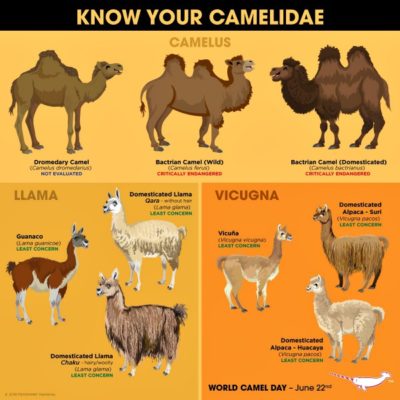
The Camel, a Miracle of Adaptation
Tylopoda
Camels belong to the suborder of Tylopoda (“calloused foot”). There’s a good reason for that: the calloused feet protect them from the warm sand. When the Camel places its feet on the ground, the calluses spread out and prevent them from sinking into the sand too much.
The Camel has two toes.
When walking, the Camel first moves both legs from one side, and then both legs from the other side (known as an ‘ambling gait’).
It is through this graceful, wave-like motion that the Camel is known as:
Safinit as-Sahra – The Ship of the Desert
And no, one doesn’t get seasick on a Camel!
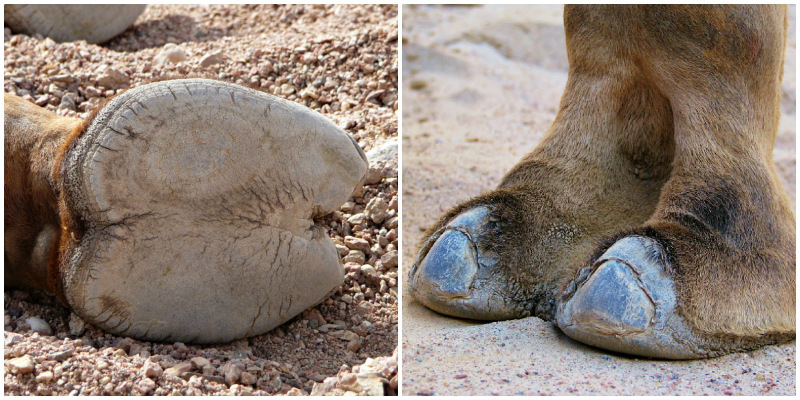
Callus Plates
In addition to the calluses as the soles of the feet, the Camel also has calluses on the elbows and knees to protect it against surfaces such as warm sand.
The most special callus site is the large callus plate that protrudes just below the chest. The Camel sits and rests on this callus plate so that its further lower body does not touch the hot sand.
Very special and symbolic is that this chest callus plate grows in the shape of … a heart!
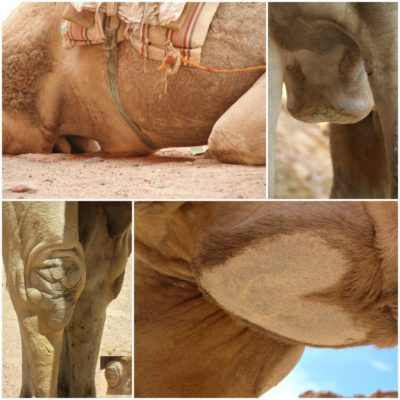
Eyes – Ears – Nose
The sight of a Camel is better than that of a human, this also applies to their sense of smell and hearing.
The eyes of the Camel have an extra inner eyelid, the eye membrane, and double rows of eyelashes with thick eyebrows to protect the eyes from dust and sand(storms).
Camel ears are upright and small, the inside of the ears has fine hairs to filter out sand and dust.
The nostrils of the Camel are protected by large muscular nose wings which the Camel can close at will in the event of heavy sandstorms.
When the Camel contracts its nose, the incoming air cools and the moisture condenses during the exhalation. Condensing is the opposite of evaporation.
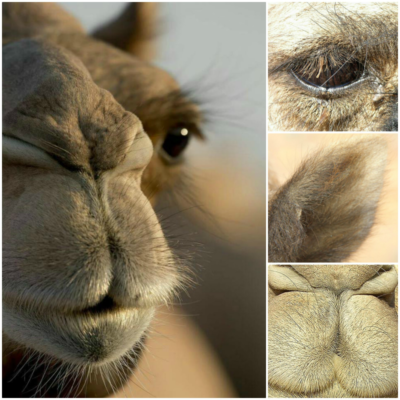
Lips & Mouth
The upper lip of the Camel is split, making them able to eat thorny branches or to graze around thorny areas in search of plant pods, for example.
An adult Camel has 34 sharp teeth, the large corner canine teeth of adult bulls also serve as a weapon. The teeth of the Camel grow throughout their lives. To wear them off, they nibble on hard material such as bones and pieces of wood.
The inside of the mouth and cheeks is special. The pink / lilac-like papillae help protect the inside of the cheeks and mouth against thorn branches and work together with the tongue and mouth muscles to push the ground twigs and branches in the right direction.
Camels also need thorny branches for the papillae. If they do not eat thorny branches for too long a period, for example because they are living on hay for too long, a papilla can become too long and hang over the tooth or molar, making it difficult to eat.
In male adult camels, the dullaa is found on the inside of the right cheek. When the camel is in rut, the dullaa swells with air to come out into a pink ball in order to impress females or scare off other males.
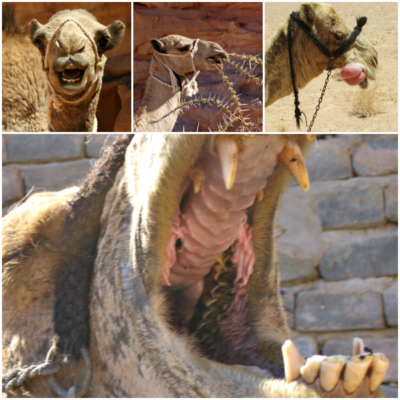
Pruners of the Desert
The Camel also takes care of the sparse vegetation in the Desert: it will never eat a plant with roots, unlike goats that eat bushes until they are totally stripped off all vegetation. The Camel also feeds on tough, thorny, salty and dried out plants that most other desert animals leave behind.
The Camel also has the ability to profit from food with a low nutritional value.
Because of its long legs and long neck, the Camel can also get its food from trees.
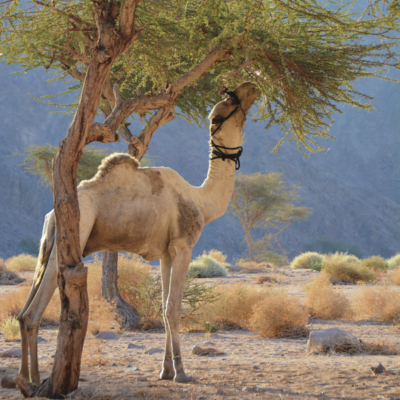
The Hump
It was long thought that the hump was intended for water storage. This is not the case.
The hump is the storage facility for fat, which is converted into energy and water during long and heavy journeys or during periods of food scarcity and drought. The camel releases the water through the exhalation that is necessary for the burning of this fat reserve.
The Camel therefore extracts energy from the fat storage in the hump in the event of food scarcity. A well-filled hump can weigh up to 40 kg. If he needs the fat storage of his hump, the hump shrinks.
A Camel can lose up to a quarter of its body weight without being in direct danger.
The Hump and therein contained fat also protects the Camel against high temperatures by absorbing heat.
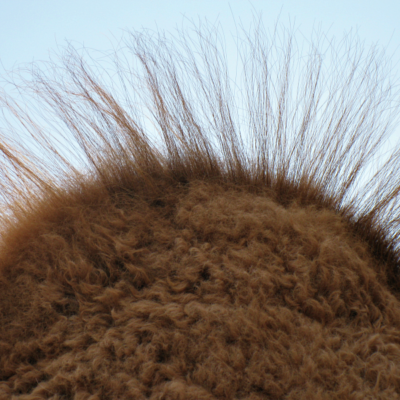
Ingenious Water Management & Body Temperature Regulation
The most special thing about the Camel is how it deals with water, moisture and temperature management against heat, cooling and cold. The Camel can also tolerate dehydration of the body better than any other mammal.
In case of severe thirst, a Camel can drink 100 liters of water in 10 minutes. Such an amount in such a short time would be fatal for any other mammal including humans. Our red blood cells would burst. However, due to its unique metabolism, the Camel is able to cope because the water is only passed on very slowly from the stomach and intestines to the rest of its body. In addition, the red blood cells of a Camel can swell up to two and a half times their initial volume without bursting.
- The kidneys absorb a large part of the fluid, so that the urine is very concentrated and the excrement also contains hardly any fluid. When a Camel threatens to dehydrate, it extracts even more moisture from its manure than usual. For example, a cow loses as much as 20 to 40 liters of water per day through the faeces, the camel only 2 liters or less.
Most mammals do not tolerate brackish or salt water, but the Camel does because the specially adapted kidneys remove the salts and concentrate it in the urine. Camels also need 8 x more salt than any other mammal.
A third special adaptation of the kidneys is that urea, the breakdown product of proteins, can be retained in the body. Together with the saliva it ends up in the rumen, where the rumen flora uses the urea for the production of proteins. - The Camel’s body temperature can sway around seven degrees Celsius, from 34 to 41 degrees Celsius. It’s body temperature can therefore rise six to seven degrees to a temperature of around 41 degrees Celsius before it becomes overheated and has to sweat to cool down. No other mammal can do this.
A thirsty camel will evaporate no more than six liters of water on a hot summer day in the desert, depending on its physical activities. - Even when the Camel loses a large part of its body weight in fluid, the organs will still function properly. His blood, for example, does not quickly become syrupy or clotted when dehydrated, no more than 10 percent moisture is extracted from it.
The red blood cells – which are smaller than in humans – continue to flow easily through the smaller blood vessels due to their oval shape. - Thermoregulation: drops of sweat evaporate under the fur on the skin itself and ensure optimum cooling. At night the temperature of a camel can drop to 34 degrees Celsius.
The felt layer works so good that temperature differences of 30 degrees were measured between the hair tip and the hair base. - A herd of resting camels will prevent excessive overheating by sitting close to each other: several animals next to each other soak up less heat than when sitting separately.
You will always see a camel sitting with its face and head towards the sun, because this way the sun’s rays only touch the narrowest part of the body and the heat absorption and water loss is minimal.
Two nice articles:
Science Alert.com : Turns Out To Be A Secret Ingredient Behind A Camel’s Ability to Survive
Latestly.com : Know Amazing Facts About Camels That Will Surprise You
THE CAMEL
“We store food for our body and for our mind. We use this when we need it.”
TREASURE KEEPER
The Camel is careful with its treasures: the scarce water and food in the Desert. It can drink up to 100 liters in one go and survive on this for weeks in heat. He hardly sweats, has dry poo and only urinates ½ liter a day in harsh times. The food is stored like fat in its hump(s).
It is also said that Camels pass on stories to each other that nourish their souls…
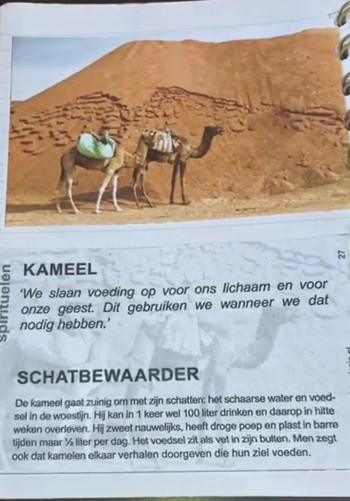
Do they not see the camels, how they were created – Quran
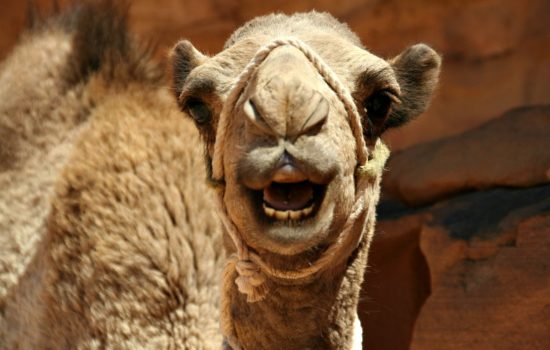
Many thanks to:
♥ All Camels: who always allow me to observe them
♥ The Muzayna Bedouin, especially the elderly for their knowledge
♥ Veterinarian Mohammed Abdelhay Elsayed
There is of course much more Camel Knowledge that I would love to share with you! Feel free to e-mail me, or even better: come and discover the Camel on a nomadic camel trek with me via DesertJoy!
